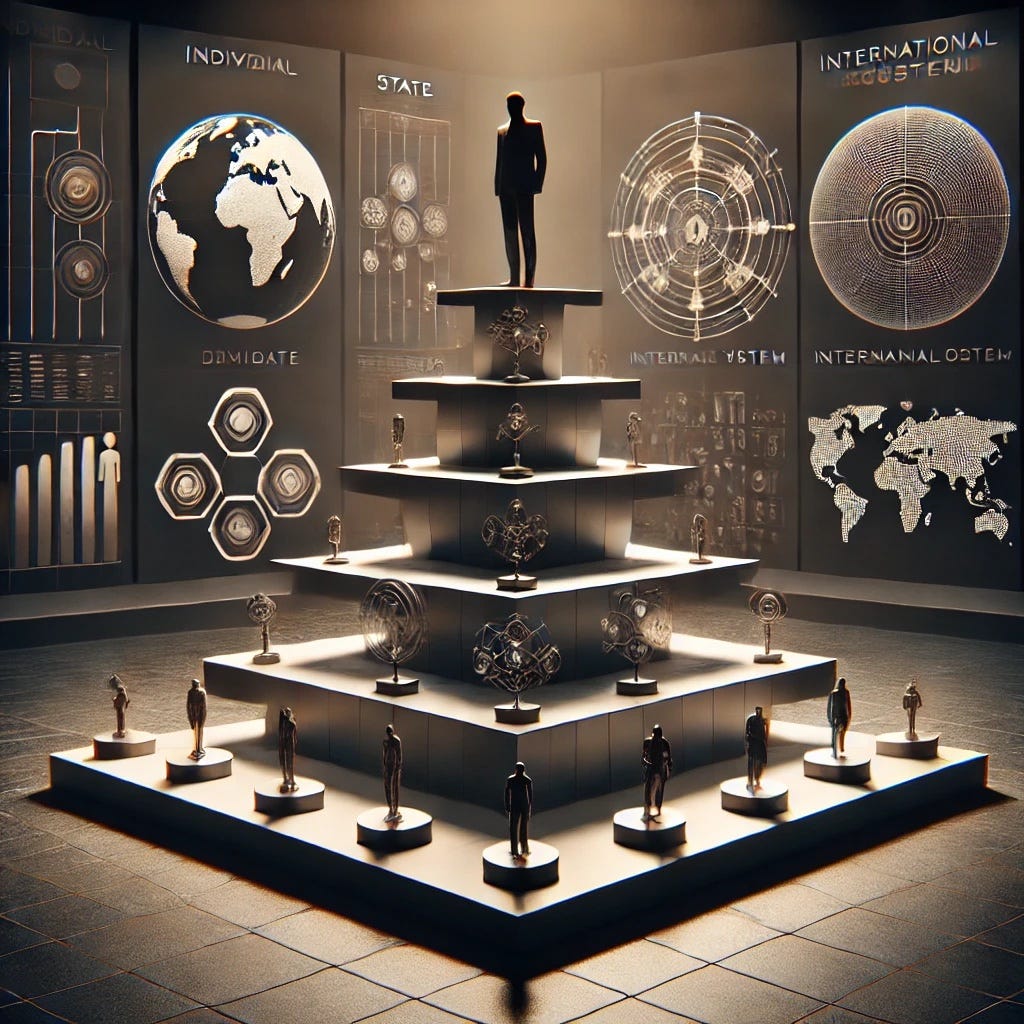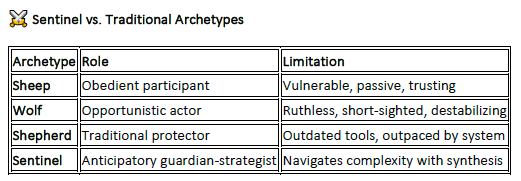By Dr. Isaiah (Ike) Wilson III
Strategic Sentinel | Founder, Wilson W.i.S.E. Consulting | The Compound Security Project
“You gotta decide who you’re gonna be in this game. Are you gonna be the wolf, the sheep, or the shepherd?”
— Denzel Washington as Alonzo Harris, Training Day (2001)“This shit’s chess, not checkers.”
— ibid.
Denzel’s Alonzo Harris, for all his menace and moral corrosion, wasn’t wrong. His line—"This shit’s chess, not checkers"—has become cultural shorthand for strategic complexity, for calculated maneuvering in contested space, and for the difference between linear simplicity and compound risk.
It’s also a powerful entry point into how we might understand today’s international security environment: chaotic, converging, and compounded.
We’re not just facing one crisis. We’re facing many, stacked on top of each other. Climate meets migration. AI meets authoritarianism. Economic fragility meets democratic erosion. And all of it is unfolding across a global system that is no longer governed by any single set of rules, norms, or power centers.
♟ I. The Gameboard: Three Levels of Analysis Revisited
The classic three-level framework from the American School of International Relations—individual, state, and system—remains one of the most useful tools for interpreting global politics. But in the current compound security era, these levels are no longer clearly bounded. They bleed into one another, accelerating uncertainty and scrambling causality.
Let’s quickly revisit the frame:
Individual Level: Leadership personalities, decision-makers, ideational drivers.
State Level: National interests, regime types, institutional strength, societal coherence.
System Level: Anarchy, polarity, power distribution, norms, institutions.
Each level still matters. But none can fully explain what’s happening alone. The crises of our time spill across them—rapidly, recursively, and often irreversibly.
🔁 II. The Compound Security Dilemma: Intersectional Threats and Fractured Foundations
Traditional security dilemmas pit one state’s defensive measures against another’s sense of vulnerability. But the compound security dilemma involves multiple, overlapping insecurities, many of which are not even military in nature—but which nonetheless produce destabilizing strategic effects.
Today’s security environment is defined by intersectionality: the convergence of environmental, technological, economic, and ideological fault lines. These aren’t just co-occurring. They’re interacting, intensifying, and amplifying one another.
✴️ Vignette A (Global): The Drought-Democracy Nexus
Consider a near-future Sub-Saharan state—once a fragile democracy, now facing prolonged drought. Agricultural collapse leads to food insecurity. Internal displacement overwhelms governance. Ethnic grievances resurface. Russia and China offer infrastructure and security packages—but at the cost of democratic rollback.
What began as climate risk metastasized into political crisis, strategic realignment, and global contestation.
✴️ Vignette B (Domestic): The Downward Spiral of the Forgotten Majority
In the American Midwest, a white, middle-class farmer—dealing with legacy debt from the 2008 crash—is now battered by drought, inflation, and automated agricultural platforms owned by foreign equity. His insurance premiums skyrocket from climate events. His children are radicalized online by ultra-nationalist channels that promise dignity through grievance.
At the individual level, he feels betrayed.
At the state level, safety nets are eroded in the name of budget cuts and "anti-woke" crusades.
At the system level, global capital outmaneuvers local labor.
What starts as a compound economic insecurity becomes a pipeline to narrative radicalization and systemic vulnerability.
🧬 Escalation: Enter the Fourth Level — Ideological Infrastructure and Memetic Warfare
This is where the game truly changes.
Beyond the traditional three levels lies a Fourth Level: the arena of transnational ideology, identity warfare, and memetic infrastructure.
This level operates beyond state borders. It connects political factions, internet subcultures, and techno-philosophies into narrative ecosystems with global reach.
Here we find:
International Identism—a transnational ethno-nationalist alliance that reimagines sovereignty through race, culture, and civilizationist hierarchies.
The Dark Enlightenment—a techno-accelerationist movement that views democracy as obsolete
MAGA Republicanism, which now functions as both domestic insurgency and international node
At this level:
Algorithms propagate tribalism faster than policies can adapt
Narratives become strategic assets and weapons
Identity becomes a terrain of warfare, not just culture
This is the fourth dimension of compound conflict: not just who governs, but who belongs, who is remembered, and who is deemed real.
🔮 III. Most-Similar Historical Analogies
We’ve been here before—sort of.
The Great Power unraveling pre-WWI, where alliances outpaced strategy.
The 1970s energy crisis, when shocks destabilized both global capital and domestic trust.
The interwar Weimar period, when democracy collapsed not through invasion—but through erosion.
Each case reminds us that complexity, when misunderstood, becomes catastrophe.
🚨 IV. Trump 2.0: Fuel on the Compound Fire
We are still barely weeks into the second Trump administration, and already the indicators are alarming:
Diplomatic pullbacks from multilateral institutions
Executive-led purges of scientific and national security professionals
Civil-military distortion, where neutrality masks complicity
Weaponized identity politics, reframed as populist restoration
In a compound environment, these aren’t isolated policy choices. They’re force multipliers—for domestic instability and international breakdown alike.
Undermining intelligence doesn’t just skew foreign policy—it weakens pandemic preparedness.
Defunding environmental programs doesn’t just shrink budgets—it destabilizes labor and land.
Purging institutions doesn’t just change staffing—it rewrites civic reality.
🚦 V. Forward Operating Narratives: ‘Speculative Futures’ from the Now
⚠️ Scenario 1: Balkanization of the Information Ecosystem
AI-driven micropropaganda fractures national audiences. Legitimacy collapses under contested narrative control.
🌪 Scenario 2: Disaster Diplomacy Replaced by Resource Grab
A Gulf Coast megastorm devastates infrastructure. Domestic response stalls. Foreign actors offer aid—but with strings attached.
🧬 Scenario 3: Biotech Weaponization in Stateless Zones
Custom-engineered pathogens are deployed by paramilitary actors. Deterrence doctrine becomes irrelevant.
✒️ Coda: The Real Game
The old paradigms are breaking.
This isn’t about left or right. It’s about compound reality versus legacy illusion. It’s about whether we’re playing checkers on a chessboard—or worse, poker in a burning casino while the rules change mid-hand.
The real game is multi-level.
It’s played in code and culture, in climate and cognition, in budgets and in bandwidth.
It is not just a war of weapons—it is a contest of worldviews, institutions, and memory.
And the question facing us is not whether we win the game—but whether we even understand the board we’re playing on.
We need leaders who see across dimensions. Who anticipate instead of react. Who recognize the intersections not just as threats—but as the terrain of transformation.
This shit’s chess—not checkers. And the clock is running.
🧩 Postscript: So... Wolf, Sheep, or Shepherd?
Let’s return to where we began.
“You gotta decide who you’re gonna be in this game: the wolf, the sheep, or the shepherd.”
— Alonzo Harris, Training Day
In the world of compound security dilemmas, stacked crises, and intersectional vulnerabilities, Alonzo’s question echoes louder than ever. But here’s the twist:
It’s a false trilemma.
❌ The Sheep
The sheep obeys, trusts, and hopes the system holds. But when institutions crack and crises converge, the sheep becomes the casualty—vulnerable, manipulated, and expendable.
❌ The Wolf
The wolf exploits instability. It thrives on asymmetry, feasts on chaos. But in a globally entangled system, predation is short-term strategy. Wolves might win the moment—but they don’t build futures.
✅ The Shepherd?
The shepherd watches, guides, protects. But even this ideal falters in today’s world:
Who protects the shepherd?
What if the flock fragments?
Can the shepherd still lead when the wolves write the laws—and the code?
✅ The Real Answer: “Yes-And. “ All Three—Evolved.
In the compound world, resilience requires integration. The most adaptive actor is not a single archetype—but a fusion of roles:
The vulnerability-awareness of the sheep (humility and connection)
The strategic acumen of the wolf (calculation without cruelty)
The ethical compass of the shepherd (but updated for asymmetry)
This isn’t a binary or even a triangle. It’s an evolution.
What we need is the Sentinel.
Not a predator.
Not a passive observer.
Not a nostalgic protector.
But a new kind of civic actor—polycentric in thought, anticipatory in action, and capable of leading through complexity, not away from it.
♟ In This Game of Compound Chess
The sheep alone will perish.
The wolves alone will destroy the gameboard.
The shepherd alone will be outflanked.
But the Sentinel—one who learns from all three—might just understand the board well enough to change the game. We must be(come) that sentinel.
🔭 So, What Is a Sentinel? ‘Sentinel Leadership’?
In the compound security context, a Sentinel is:
🔹 Observer with Foresight
Sees across levels: individual, state, system, and ideological terrain.
Anticipates convergence before it cascades.
Watches not only for threat, but for change—emergent dynamics, pattern shifts, unspoken risks.
🔹 Guardian with Ethics
Not just protecting “the flock,” but protecting pluralism, truth, and possibility.
Anchored in a civic ethic, but not naïve—aware that the old forms of protection (institutions, norms, deterrence) may no longer be enough.
🔹 Strategist with Adaptability
Combines the cunning of the wolf (tactical acuity) with the principled restraint of the shepherd.
Makes moves based not on ego or ideology, but on synthesis of threat, opportunity, and consequence.
🔹 Agent of Narrative Integrity
Understands that in a world of memetic warfare, truth is strategic terrain.
Works to reinforce shared memory, civic storylines, and public reasoning—while resisting false binaries and weaponized grievance.
⚔️ Sentinel vs. Traditional Archetypes
🧭 Why We Need Sentinels Now
Because this moment isn’t just about resisting collapse. It’s about preparing for what’s next.
We need leaders, thinkers, and citizens who can:
Move across scales of threat and possibility
See the ideological layer of conflict as real as the physical
Combine moral seriousness with strategic sharpness
The Sentinel is the player who doesn’t just understand the chessboard.
They see the compound layers beneath it—and act accordingly.
📬 Subscribe to Compound Security, Unlocked for essays on compound-era leadership, strategic foresight, and the real front lines of 21st-century security.




